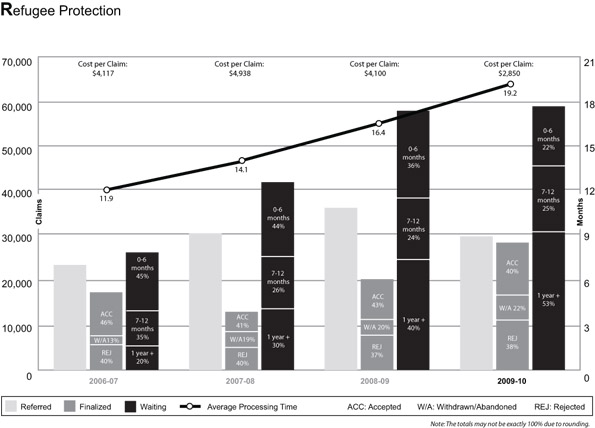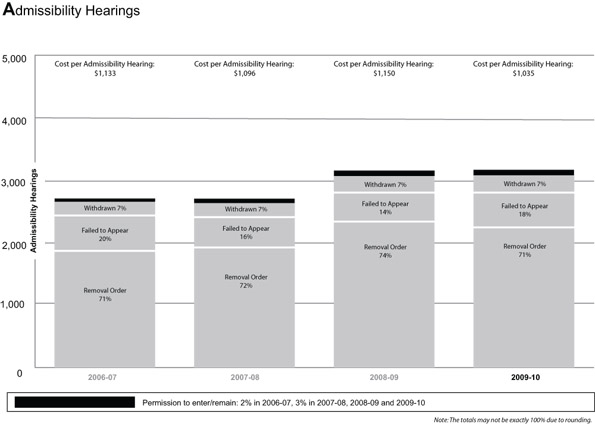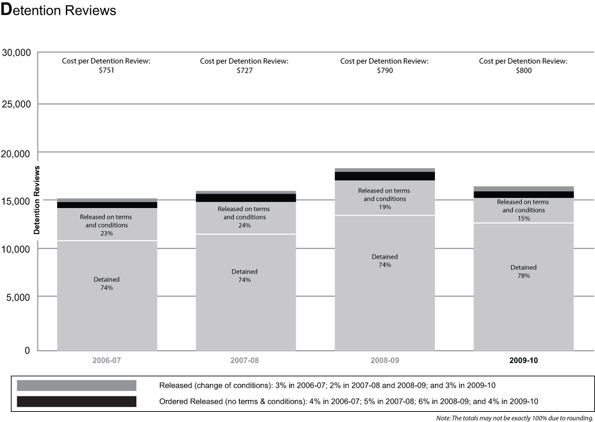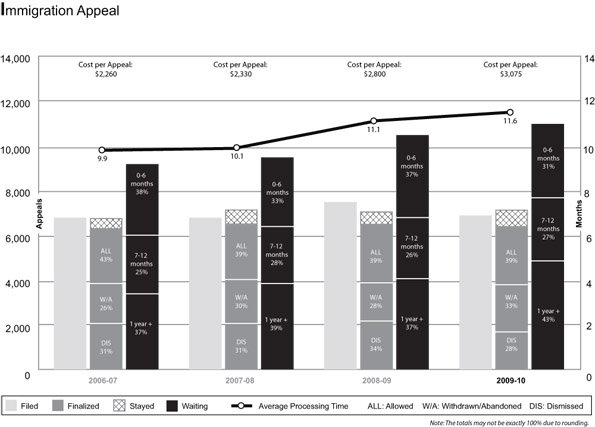Common menu bar links
Breadcrumb Trail
ARCHIVED - Immigration and Refugee Board of Canada - Report
 This page has been archived.
This page has been archived.
Archived Content
Information identified as archived on the Web is for reference, research or recordkeeping purposes. It has not been altered or updated after the date of archiving. Web pages that are archived on the Web are not subject to the Government of Canada Web Standards. As per the Communications Policy of the Government of Canada, you can request alternate formats on the "Contact Us" page.
Section II – Analysis of Program Activities
Strategic Outcome and Program Activities
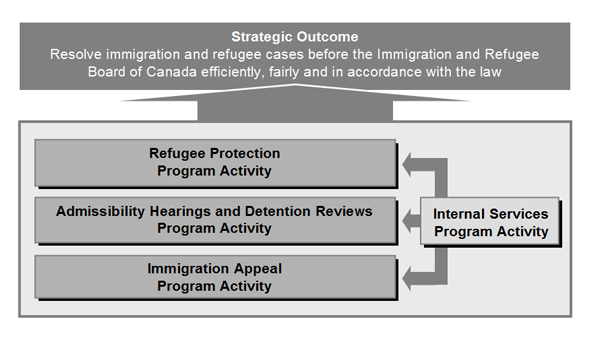
2009-10 Highlights
- Strategic outcome successfully achieved
- Met or exceeded funded case resolutions in all program activities; over 55,000 cases heard
- Fewer than 1% of decisions overturned by the Federal Court
Each of the three core program activities are focused on the efficient and fair resolution of the immigration and refugee cases that are before the Board. Combined, they are responsible for all tribunal decisions and case resolutions, and for a successful strategic outcome.
The achievement of the IRB's strategic outcome is dependent on both the quantity and the quality of the output. For instance, a large number of cases must be finalized every year in order to avoid lengthy delays for individuals waiting for a decision on their case. At the same time, the quality and fairness of each decision must be assured. During 2009-10, the strategic outcome was successfully achieved. The IRB met or exceeded the funded and anticipated number of finalized cases in each of its program activities. Approximately 55,350 cases were heard, a 14 percent increase over the previous year. The Board also met its quality performance target, with only 0.4 percent of its decisions overturned by the Federal Court, an indication of the high level of fairness and quality of the decisions rendered by the IRB.
The following pages provide a performance summary as well as information on overall financial and human resources for each of the IRB's four program activities during the 2009-10 reporting period.
Program Activity 1: Refugee Protection
Description
The Refugee Protection Division (RPD) delivers the IRB's Refugee Protection program activity. It determines claims for refugee protection made in Canada. Processing of refugee claims is the main focus of the IRB's activities and resources. Through the work of the RPD, Canada fulfils its obligations as a signatory to a number of international human rights
conventions.
Additional information on the RPD is available at
www.irb-cisr.gc.ca/eng/tribunal/rpdspr/pages/index.aspx
2009-10 Highlights
- 29,900 new refugee claims filed, 18% fewer than last year
- 28,500 refugee claims resolved, 3,500 more than planned
- Case inventory increased from 57,600 to 59,000
| 2009-10 Financial Resources ($ Millions) |
2009-10 Human Resources (FTEs) |
||||
| Planned Spending | Total Authorities | Actual Spending | Planned | Actual | Difference |
|---|---|---|---|---|---|
| 60.3 | 62.8 | 58.2 | 591 | 534 | (57) |
| Expected Result: Quality decisions rendered and cases resolved in a timely manner regarding refugee protection claims made in Canada | Performance Status: Exceeded | |
| Performance Indicator | Target | Performance Summary |
|---|---|---|
| Clarity, completeness and conciseness of IRB reasons for decisions | Develop criteria for samples of reasons for decisions | Indicators and criteria developed and piloted; implementation planned for 2010-11 |
| Percentage of cases finalized without a hearing (expedited process) | 8% | 10% |
| Ratio of finalized cases to referred cases | 50,000 refugee protection claim referrals were expected in 2009-10; we expected to finalize between 21,000 and 25,000 claims, depending on the number of decision-makers available, resulting in a ratio of finalized to referred cases of 42% to 50% | During 2009-10, 29,900 new claims were referred and 28,500 claims were finalized, resulting in a ratio of 95%. The ratio was affected by a large reduction in intake and a substantial increase in the number of finalizations; see pages 8 and 15 for more detailed explanations |
| Average cost per claim finalized1 | $3,200 to $3,800, depending on the number of claims finalized | $2,850 |
| Average processing time (from referral to finalization) of finalized cases | Increase to 18.5 months, based on the inventory and the number of decision-makers available | Increase to 19.2 months due to an increase in the RPD inventory and the number of referrals exceeding the funded capacity |
1: Average costs are calculated as a function of total expenditures and finalized cases. Projections and results are largely affected by variations in the number of finalized cases.
Performance Analysis
Decision-makers. The RPD depends on experienced, highly trained decision-makers to provide well-reasoned quality decisions in a timely manner. During 2009-10, a total of 43 decision-makers were appointed or re-appointed to the RPD, bringing the total to 125 decision-makers by the end of the fiscal year, two decision-makers short of its funded complement.
Case inventory. The RPD began the fiscal year with a pending inventory of 57,600 cases. The Division received 29,900 new refugee protection claim referrals in 2009-10, a reduction of 6,100 from the previous year (including 3,800 fewer from Mexico and 3,100 fewer from Haiti). The RPD, with a full complement of decision-makers, exceeded expectations, finalizing 28,500 claims, 3,500 more than anticipated. This 12 percent increase was primarily due to improvements in productivity as mentioned below, an increase in the number of expedited claims, and an increase in the number of abandoned and withdrawn claims, mainly from the Czech Republic and Mexico. This resulted in a pending inventory of 59,000 claims at the end of 2009-10. However, the RPD needs additional resources to deal with its largest inventory ever. Without increased resources, refugee claimants, many of whom have faced very difficult circumstances in their country of origin, will face the added stress and uncertainty associated with lengthy delays in the resolution of their claim.
Productivity increase. While maintaining the quality and fairness of their decisions, RPD decision-makers increased their average individual productivity by approximately 2 percent in 2009-10. This increase was largely attributed to training, internal process improvements, and strategic monitoring of postponements, adjournments and time taken to render reasons.
Lessons Learned
Performance measurement targets were implemented in 2009-10 and a greater emphasis was placed on monitoring postponements and adjournments. The productivity results demonstrate the effectiveness of these strategies. The RPD also had an increase in the percentage of decisions rendered orally, thereby contributing to the timely completion of cases.
Benefits for Canadians
Through the work of the Refugee Protection program activity, Canada accepts only those refugee protection claimants who are in need of protection. Canada provides a safe haven to persons with a well-founded fear of persecution as well as to those facing a danger of torture or a risk to their life, or a risk of cruel and unusual treatment or punishment if returned to their country of origin. This contributes to a safe and secure world environment. The RPD aids Canada in meeting its international obligations.
Program Activity 2: Admissibility Hearings and Detention Reviews
Description
The Immigration Division (ID) delivers the Admissibility Hearings and Detention Reviews program activity. It holds hearings for foreign nationals or permanent residents who, under the provisions of the IRPA, are alleged to be inadmissible to Canada or are detained. Detainees must be seen by the ID within 48 hours after their referral, or without delay thereafter,
and subsequent reviews must be conducted within specific statutory time frames. Decision-makers must balance the right to individual liberty with the safety and security interests of Canadians.
Additional information on the ID is available at
www.irb-cisr.gc.ca/eng/tribunal/idsi/pages/index.aspx
2009-10 Highlights
- 3,150 admissibility hearings were finalized
- 16,500 detention reviews were carried out
- Intake started returning to previous levels
| 2009-10 Financial Resources ($ Millions) |
2009-10 Human Resources (FTEs) |
||||
| Planned Spending | Total Authorities | Actual Spending | Planned | Actual | Difference |
|---|---|---|---|---|---|
| 11.4 | 12.6 | 9.0 | 63 | 70 | 7 |
| Expected Result: Quality decisions rendered and cases resolved in a timely manner regarding admissibility hearings and detention reviews | Performance Status: Met All | |
| Performance Indicator | Target | Performance Summary |
|---|---|---|
| Clarity, completeness and conciseness of IRB reasons for decisions | Develop criteria for samples of reasons for decisions | Indicators and criteria developed and piloted; implementation planned for 2010-11 |
| Percentage of admissibility hearing cases concluded to referred cases | 90-95%1 | 105% as referrals from the previous reporting period were also concluded |
| Percentage of concluded detention review cases within statutory time frame | 97%2 | 98% |
| Average cost of admissibility hearing3 | $950 | $1,035 |
| Average cost of detention review3 | $750 | $800 |
| Percentage of admissibility hearings concluded with a hearing within six months from referral | 86-88%1 | 92% |
1: Detention reviews take priority over admissibility hearings due to legislative time requirements. The number of referrals from the Canada Border Services Agency (CBSA) affects the capacity of the ID to conduct admissibility hearings.
2: Factors outside the IRB's control, such as prison lockdown, impede the achievement of 100 percent compliance.
3: Average costs are calculated as a function of total expenditures and finalized cases. Projections and results are largely affected by variations in the number of finalized cases.
Performance Analysis
Intake levels. The number of cases before the ID depends on the number of cases referred by the CBSA. Over the four previous fiscal years, referrals of admissibility hearings had increased by 29 percent while referrals of detention reviews had increased by 19 percent. This trend reversed in 2009-10 because of a 7 percent reduction in referrals of admissibility hearings and a 10 percent reduction in referrals of detention reviews. Through efficiencies, the ID managed an elevated workload within existing resources, and concluded detention review cases within the legislated time frames.
Admissibility hearings. During 2009-10, the ID finalized 3,150 admissibility hearings, the same as during the previous year. Of the admissibility hearings finalized, 71 percent resulted in a removal order being issued because the person was determined inadmissible, 3 percent resulted in permission to enter or to remain in Canada, 7 percent were subject to the withdrawal of the inadmissibility allegation by the CBSA at the hearing, and 18 percent were closed after the person failed to appear for the hearing. The results and trends are illustrated in the graph below.
Detention reviews. During 2009-10, the ID finalized approximately 16,500 detention reviews, 10 percent fewer than the previous year. Close to 4,500 detention reviews were finalized without a decision because the case was rescheduled or the person was removed, released or detained by courts prior to a scheduled review. The remaining 12,000 detention reviews were finalized with a decision. The ID, supported by the Operations Branch, successfully finalized the detention reviews of the British Columbia marine arrivals from Sri Lanka in October 2009. The results and trends are illustrated in the graph below.
Lessons Learned
The ID met or exceeded expectations in all of its activities. As mentioned in the RPP, the ID planned to develop and implement case management standards to closely monitor processing times, adjournments, postponements and case readiness measures, all with a view to completing a greater number of cases within a six-month time frame. This close monitoring of the drivers that affect processing time brought positive results. The Division plans to build on this success and further refine its monitoring activities in 2010-11.
Benefits for Canadians
The ID renders decisions that maintain the security of Canadian society and uphold Canada's tradition of justice and fairness for individuals. Through its work on admissibility hearings and detention reviews, the ID contributes to the maintenance of the balance between individual rights and the safety and security of Canadians.
Program Activity 3: Immigration Appeal
Description
The Immigration Appeal Division (IAD) delivers the Immigration Appeal program activity. It hears immigration appeals from Canadian citizens and permanent residents whose applications to sponsor close family members to Canada have been refused. Other key functions include hearing appeals from permanent residents, foreign nationals with a permanent resident visa,
protected persons who have been ordered removed from Canada, and permanent residents outside Canada who are alleged to have not fulfilled their residency obligation.
Additional information on the IAD is available at
www.irb-cisr.gc.ca/eng/tribunal/iadsai/pages/index.aspx
2009-10 Highlights
- 6,900 new immigration appeals filed
- 7,200 appeals resolved (6,400 finalized and 800 stays of removal)
- Inventory of unresolved appeals increased from 9,000 to 9,300
- Average processing time increased from 11.1 to 11.6 months
| 2009-10 Financial Resources ($ Millions) |
2009-10 Human Resources (FTEs) |
||||
| Planned Spending | Total Authorities | Actual Spending | Planned | Actual | Difference |
|---|---|---|---|---|---|
| 13.2 | 16.5 | 15.6 | 115 | 121 | 6 |
| Expected Result: Quality decisions rendered and cases resolved in a timely manner regarding immigration appeals | Performance Status: Met All | |
| Performance Indicator | Target | Performance Summary |
|---|---|---|
| Clarity, completeness and conciseness of IRB reasons for decisions | Develop criteria for samples of reasons for decisions | Indicators and criteria developed and piloted; implementation planned for 2010-11 |
| Percentage of appeals finalized without a hearing | 45% | 42% |
| Ratio of finalized appeals to filed appeals | 7,000 appeals were expected to be filed in 2009-10; we expected to finalize between 5,800 and 6,500 appeals, depending on the number of decision-makers available. This would result in a ratio of "finalized to filed appeals" of 83% to 93% | 6,900 appeals were filed in 2009-10 and 6,400 were finalized, resulting in a ratio of 93% |
| Average cost per appeal finalized1 | $2,700 to $3,000, depending on the number of appeals finalized | $3,075 |
| Average appeal processing time | Increase to 11.5 months, based on the inventory and the available decision-maker complement | 11.6 months |
1: Average costs are calculated as a function of total expenditures and finalized cases. Projections and results are largely affected by variations in the number of finalized cases.
Performance Analysis
Decision-makers. The IAD depends on highly trained decision-makers to conduct fair and efficient hearings and provide well-reasoned quality decisions in a timely manner. During the 2009-10 fiscal year, the IAD welcomed many new decision-makers which addressed the shortfall in its complement. However, the majority of IAD decision-makers were still within their first mandate. Despite the lack of a large group of experienced decision-makers in a small division, the IAD maintained high productivity by maximizing efficient use of case management strategies.
Key statistical highlights. In 2009-10, approximately 6,900 appeals were filed, 100 appeals fewer than the projected 7,000. The Division's productivity remained very high with almost 7,200 resolutions of appeals. Of those, 6,400 were appeal finalizations and 800 were stays of removal orders. Nonetheless, the case inventory grew slightly from 10,500 at the beginning of 2009-10 to 11,000 at year-end. However, the inventory of unresolved appeals (which excludes stayed appeals waiting for finalization) increased only 3 percent from 9,000 to 9,300 cases. The average case processing time increased from 11.1 to 11.6 months, or 4 percent.
Business improvements. The IAD continued to promote adjudication strategies to enhance consistency in decision-making. Innovative case management strategies were further refined to promote earlier resolution of appeals, greater hearing readiness and high productivity. The IAD also enhanced its communications with stakeholders across the country on administrative and adjudicative matters.
Lessons Learned
During a period of a shortfall in decision-makers, having strong adjudicative support is especially important to sustain high productivity through increased hearing readiness and early resolution of cases. The flexible sharing of decision-maker resources among regions continued to be crucial to the IAD's efforts to address the backlog in Central Region appeals. The need to coordinate resources with the CBSA continued to be a challenge in many areas where the cooperation of Minister's counsel is important, for example, in alternative dispute resolutions and for hearings in which the Minister's counsel appears only through written submissions. The IAD will capitalize on these lessons and continue to improve its efficiency and productivity.
Benefits for Canadians
Through its sponsorship appeals work, the IAD recognizes the contributions of immigrants to the strength and vitality of Canadian society and culture, as well as the Government's commitment to family reunification. Through its work on removal order appeals, the IAD enhances public safety while ensuring that individuals' fundamental rights are respected.
Program Activity 4: Internal Services
Description
Internal Services are groups of related activities and resources required to support the needs of all three tribunal programs and other corporate obligations of the IRB. These services are: Management and Oversight; Communications, Legal, Human Resources Management, Financial Management; Information Management; Information Technology; Procurement and Assets
Management; Internal Audit and Evaluation; and Other Administrative Services. Internal Services include only those activities and resources that apply across the organization and not those provided to a specific program.
2009-10 Highlights
- Integrated national training program delivered
- Audit committee created
- Chief financial officer model implemented
- 5-year strategy developed to improve planning, quality and efficiency of support services
| 2009-10 Financial Resources ($ Millions) |
2009-10 Human Resources (FTEs) |
||||
| Planned Spending | Total Authorities | Actual Spending | Planned | Actual | Difference |
|---|---|---|---|---|---|
| 28.5 | 31.8 | 31.3 | 257 | 248 | (9) |
1: Commencing in the 2009-10 Estimates cycle, the resources for the Internal Services program activity are displayed separately from other program activities; they are no longer distributed among the remaining program activities, as was the case in previous Main Estimates. This has affected the comparability of spending and FTE information by program activity between fiscal years.
Performance Analysis
Management and oversight. During 2009-10, the IRB improved the support provided to senior management. The Board implemented the Chief Financial Officer model in accordance with the new Policy on Financial Management Governance. An independent Audit Committee was created in accordance with the Treasury Board Secretariat (TBS) Internal Audit Policy to provide the Chairperson with objective advice and assurance on IRB operations. Also, the Corporate Planning and Services Branch developed a comprehensive Branch strategy to improve planning as well as the quality and efficiency of service support operations over the next five years.
Communications. The IRB improved the understanding of its mandate and role amongst media, the public and counsel. The Board shared best practices and collaborated with national and international partners. The IRB, with other Canadian government organizations, participated in a capacity building project with the government of South Africa. The Board took part in numerous outreach events ranging from national and international conferences to other government departments' events. Participation in these events promoted exchanges on key policy and procedural issues between IRB personnel, international and domestic stakeholders and government partners, and resulted in improved cooperation and communication.
Legal. Legal Services continued to provide legal advice in support of all of the IRB's strategic priorities, including the implementation of measures to improve the quality of IRB proceedings. During 2009-10, specific efforts were directed at guidelines to reduce avoidable adjournments and postponements in all three IRB divisions, the newly revised Protocol Addressing Member Conduct Issues (the IRB's complaint process to ensure the integrity of IRB proceedings), the use of official languages in proceedings, and the development of procedures for complex cases involving classified information related to national security or criminal intelligence. Advice was also provided on special procedures designed to prioritize family class sponsorship appeals for victims of the earthquake in Haiti. Regional offices focused significant resources on the training and support of decision-makers due to a large number of new appointments.
Human resources (HR) management. In 2009-10, the Board pursued its efforts in rebuilding and renewing its capacity to fulfill its HR service requirements in a timely and effective manner. With respect to staffing, as a result of the Public Service Commission (PSC) audit, the IRB implemented an action plan to address the recommendations made by the PSC. Adjustments to policies, procedures and practices, combined with learning activities have contributed to the renewal of the departmental capacity in staffing. A more integrated approach to HR planning was undertaken with a view to developing targeted strategies in all HR areas. Fiscal year 2009-10 was notable for learning and development; almost 330 decision-makers and adjudicative support personnel from all divisions participated in a three-day Integrated National Training Seminar, and over 70 decision-makers completed training sessions. Learning strategies were also identified by the professional community, to strengthen continuous learning as well as the competencies of the IRB's workforce.
Financial management. During 2009-10, much effort was dedicated to the implementation of the new suite of TBS financial policies and directives, including the conduct of an impact analysis, amendments to existing internal processes and practices, communications and training. Examples of such initiatives include substantial changes to the IRB Financial Directive on the Delegation of Financial and Contracting Related Authorities and the development of a new Financial Directive on the Financial Management of Pay Administration. In addition, substantial effort was dedicated to strengthening the functional reporting framework and to supporting the planning efforts associated with the tabling of Bill C-11, the Balanced Refugee Reform Act.
Information management. During the period under review, the IRB planned the implementation of a new function-based file classification structure that will be piloted in the next fiscal year. Also, the IRB made great strides to remove all of its information holdings from a private firm where they are currently warehoused. It is expected that by July 2010, the last of the IRB's files will be transferred to Library and Archives Canada.
Information technology (IT). The IRB, in accordance with its three-year strategic IT plan, has focused on the planning and tactical deployment of process improvements. During 2009-10, the Board continued aligning and integrating its IT strategies and architecture to its strategic priorities. The development and implementation of new solutions that satisfy business needs, such as the Interactive Scheduling Interface (a national application to improve case scheduling in the RPD) and the incident management system have improved technical support and business performance. There are also ongoing efforts to maintain and support existing information systems.
Procurement and assets management. The IRB's procurement program has been significantly improved and now reflects a consistent IRB-wide approach to procurement file management, reporting, and application of TBS and Public Works and Government Services Canada policies and procedures. One notable improvement for 2009-10 was the creation of an electronic logging system which immediately resulted in economies of scale. The IRB has also improved its asset management capability by implementing a database in the regions that helps track IT and non-IT assets. The asset management policy and procedures are currently being reviewed by senior management and should be implemented in 2010-11.
Internal audit and evaluation. During 2009-10, the IRB established an independent Audit Committee. Through internal workshops and training with the Office of the Comptroller General, the committee was equipped to carry out its assurance and advisory role to the Chairperson. In addition, the Internal Audit section initiated a review of its mandate and the development of its risk-based audit plan with the objective of improving the effectiveness of the IRB's risk management, control and governance processes. Not subject to the TBS Policy on Evaluation as a small department, the IRB actively pursued evaluation projects nonetheless. The external evaluation of the IRB's case scheduling process was completed and an action plan is now under way. Performance measurement of decision quality began in full force and is scheduled to be completed in 2010-11.

